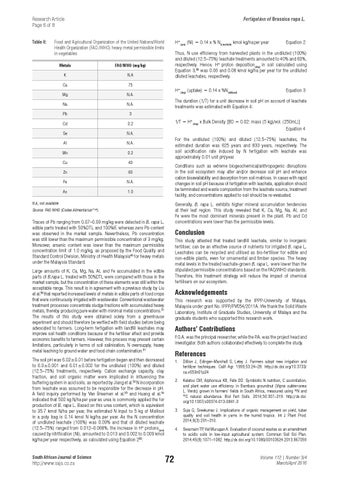Research Article Page 6 of 8 Table 8:
Fertigation of Brassica rapa L.
Food and Agricultural Organization of the United Nations/World Health Organization (FAO /WHO) heavy metal permissible limits in vegetables Metals
FAO/WHO (mg/kg)
K
N.A
Ca
75
Mg
N.A.
Na
N.A.
Pb
3
Cd
0.2
Se
N.A.
Al
N.A.
Mn
0.2
Cu
40
Zn
60
Fe
N.A.
As
1.0
H+(pro) (Ni) = 0.14 x % N(Leachate) kmol kg/ha per year
Thus, N use efficiency from harvested plants in the undiluted (100%) and diluted (12.5–75%) leachate treatments amounted to 40% and 60%, respectively. Hence, H+ proton deposition(dep) in soil calculated using Equation 3,56 was 0.06 and 0.08 kmol kg/ha per year for the undiluted diluted leachates, respectively. H+(dep) (uptake) = 0.14 x %N(utilised)
1/T = H+(dep) x Bulk Density [BD = 0.02: mass (5 kg)/vol. (250mL)] Equation 4 For the undiluted (100%) and diluted (12.5–75%) leachates, the estimated duration was 625 years and 833 years, respectively. The soil acidification rate induced by N fertigation with leachate was approximately 0.01 unit pH/year. Conditions such as extreme biogeochemical/anthropogenic disruptions in the soil ecosystem may alter and/or decrease soil pH and enhance cation bioavailability and desorption from soil matrices. In cases with rapid changes in soil pH because of fertigation with leachate, application should be terminated and waste composition from the leachate source, treatment facility, and concentrations applied to soil should be re-evaluated. Generally, B. rapa L. exhibits higher mineral accumulation tendencies at their leaf region. This study revealed that K, Ca, Mg, Na, Al, and Fe were the most dominant minerals present in the plant. Pb and Cd concentrations were lower than the permissible levels.
Source: FAO/WHO (Codex Alimentarius47,48).
Traces of Pb ranging from 0.07–0.09 mg/kg were detected in B. rapa L. edible parts treated with 50%DTL and 100%IF, whereas zero Pb content was observed in the market sample. Nevertheless, Pb concentration was still lower than the maximum permissible concentration of 3 mg/kg. Moreover, arsenic content was lower than the maximum permissible concentration limit of 1.0 mg/kg, as proposed by the Food Quality and Standard Control Division, Ministry of Health Malaysia49 for heavy metals under the Malaysia Standard.
Conclusion This study attested that treated landfill leachate, similar to inorganic fertiliser, can be an effective source of nutrients for irrigated B. rapa L. Leachates can be recycled and utilised as bio-fertiliser for edible and non-edible plants, even for ornamental and timber species. The heavy metal levels in the treated leachate-grown B. rapa L. were lower than the stipulated permissible concentrations based on the FAO/WHO standards. Therefore, this treatment strategy will reduce the impact of chemical fertilisers on our ecosystem.
Large amounts of K, Ca, Mg, Na, Al, and Fe accumulated in the edible parts of B.rapa L. treated with 50%DTL were compared with those in the market sample, but the concentration of these elements was still within the acceptable range. This result is in agreement with a previous study by Liu et al.50 that reported increased levels of metals in edible parts of food crops that were continuously irrigated with wastewater. Conventional wastewater treatment processes concentrate sludge fractions with accumulated heavy metals, thereby producing pure water with minimal metal concentrations.51 The results of this study were obtained solely from a greenhouse experiment and should therefore be verified with field studies before being advocated to farmers. Long-term fertigation with landfill leachates may improve soil health conditions because of the fertiliser effect and provide economic benefits to farmers. However, this process may present certain limitations, particularly in terms of soil salinisation, N oversupply, heavy metal leaching to ground water and food chain contamination.51
Acknowledgements This research was supported by the IPPP-University of Malaya, Malaysia under grant No. IPPP/PV054/2011A. We thank the Solid Waste Laboratory, Institute of Graduate Studies, University of Malaya and the graduate students who supported this research work.
Authors’ Contributions F.O.A. was the principal researcher, while the P.A. was the project head and investigator. Both authors collaborated effectively to complete the study.
References
The soil pH was 6.02±0.01 before fertigation began and then decreased to 6.0±0.001 and 6.01±0.002 for the undiluted (100%) and diluted (12.5–75%) treatments, respectively. Cation exchange capacity, clay fraction, and soil organic matter were implicated in influencing the buffering system in acid soils, as reported by Jiang et al.52 N incorporation from leachate was assumed to be responsible for the decrease in pH. A field inquiry performed by Van Breemen et al.53 and Huang et al.54 indicated that 500 kg N/ha per year as urea is commonly applied the for production of B. rapa L. Based on this urea content, which is equivalent to 35.7 kmol N/ha per year, the estimated N input to 5 kg of Mollisol in a poly bag is 0.14 kmol N kg/ha per year. As the N concentration of undiluted leachate (100%) was 0.09% and that of diluted leachate (12.5–75%) ranged from 0.012–0.068%, the increase in H+ protons(pro) caused by nitrification (Ni), amounted to 0.013 and 0.002 to 0.009 kmol kg/ha per year respectively, as calculated using Equation 255:
http://www.sajs.co.za
Equation 3
The duration (1/T) for a unit decrease in soil pH on account of leachate treatments was estimated with Equation 4:
N.A, not available
South African Journal of Science
Equation 2
1. Dillion J, Edinger–Marshall S, Letey J. Farmers adopt new irrigation and fertilizer techniques. Calif Agr. 1999;53:24–28. http://dx.doi.org/10.3733/ ca.v053n01p24 2. Keletso CM, Alphonsus KB, Felix DD. Symbiotic N nutrition, C assimilation, and plant water use efficiency in Bambara groundnut (Vigna subterranea L. Verdc) grown in farmers’ fields in South Africa, measured using 15N and 13 C natural abundance. Biol Fert Soils. 2014;50:307–319. http://dx.doi. org/10.1007/s00374-013-0841-3 3. Suja G, Sreekumar J. Implications of organic management on yield, tuber quality and soil health in yams in the humid tropics. Int J Plant Prod. 2014;8(3):291–310. 4. Swarnam TP, Vel Murugan A. Evaluation of coconut wastes as an amendment to acidic soils in low-input agricultural system. Commun Soil Sci Plan. 2014;45(8):1071–1082. http://dx.doi.org/10.1080/00103624.2013.867059
72
Volume 112 | Number 3/4 March/April 2016
